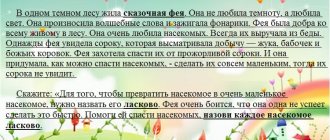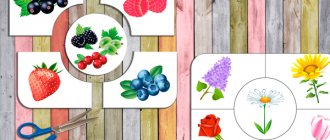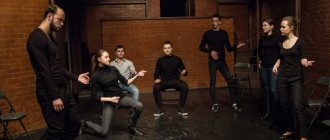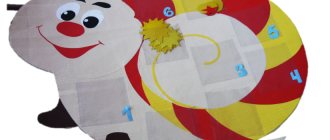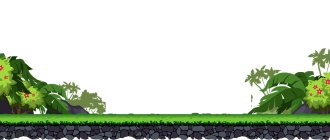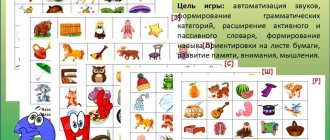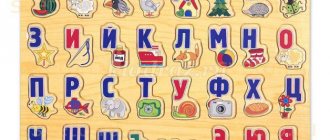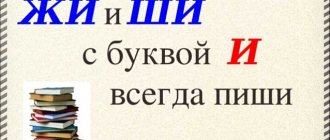An important point in the development of a child, his preparation for school, is to learn to determine the sequence of events. The didactic game “Logic Chains” is suitable for training. The cards need to be printed, cut into squares and asked to determine what comes first and what comes next. Don’t rush your child, let him think carefully, use logic, explain his point of view, and then he will succeed faster and easier. For children 6-7 years old, you can offer to compose a short story using pictures arranged in a logical order as a way to develop speech.
One hundred first? What then?
Target. Teach children to coherently express their thoughts, compose complex sentences, and determine cause and effect in a given situation. Learn to build sentences using words because, because of that, therefore. Develop an understanding of simple cause-and-effect relationships. The set includes a series of pictures depicting simple everyday scenes. The child must understand what is the cause and what is the consequence of what is shown in the pictures. The material can be used to master prepositional-case constructions.
Tasks. Learn to compose a story, expand the child’s vocabulary, develop logical thinking and coherent speech; learn to systematize acquired knowledge.
Making pictures from parts
There is a lot of literature on this topic, I use these manuals:
- Children's health kit;
- A set of pictures on social development
- Illustrations on children's speech activity.
I also use homemade materials in my work, download pictures from the Internet and make games. So, that was a small digression, let's get back to the topic of conversation.
A drawing that is divided along straight lines into several parts is split. A preschooler should not think about the shape of a detail in a drawing; he concentrates on the full image.
When a child collects a drawing, he must imagine what he is collecting, what image he will get. In this case, he must correlate the pieces with the image so that the correct place is allocated to it. Otherwise the illustration will not work. This requires concentration, seriousness, and attentiveness from children.
When folding cut images, the baby begins to realize the objective integrity and compose an illustration from parts. He trains his memory, develops thinking, and spatial orientation. Drawings are great for improving fine motor skills. By consolidating knowledge about objects and phenomena, assembling a whole from pieces, the goal of the cut-out pictures game is formed.
Download and print cards for the game
Food theme
Domestic situations
From simple to complex
At first it is better to use the simplest designs with a small number of individual pieces. The image should be familiar to the baby. A good option is two similar pictures, one of which is divided into 2 parts. In this case, one can be a sample.
After the child masters this fun, he will not need an example picture. For this game, drawings from coloring books or old books will be useful. It will be much more interesting if you draw them yourself. Use bright, but not irritating colors.
First, cut the images into two, then into three parts. Then increase the number of pieces gradually when the child folds the previous drawing on his own. You should know that the number of elements collected increases, and their size decreases. There are times when a baby puts together pictures with large pieces easier.
The number of items should be selected in accordance with the age and special qualities of your child.
Example of methodological support (for everyday stories 2)
By the age of 3.5 years, children normally understand simple cause-and-effect relationships. But the mass of children with speech disorders experience difficulties in understanding not only the logical-grammatical structure, but also the very cause-and-effect relationships that this construction denotes. Due to the lack of ability to determine the causes and consequences of what happened, children incorrectly construct phrases, incorrectly use the phrase “because”, “due to the fact that”, etc. This series of pictures contains cause and effect. They also need to print cards with linking words “because”, “due to the fact that”, “therefore”. Pairs of pictures are offered in order of complexity: first, obvious consequences and causes, then more complex ones.
1. “Misha poured the juice carelessly” and “There is a puddle on the table.” 2. “The boy got caught in the rain” and “The boy is wet.” 3. “Masha fell” and “Masha is crying.” 4. “Masha was given a doll” and “Masha is glad.” 5. “Misha and Seryozha fought” and “Misha and Seryozha are bruised.” 6. “Masha eats snow” and “Masha has a sore throat.” 7. “Vasya teases the dog” and “The dog bites Vasya.” 8. “Petya rides a bicycle and looks at a crow” and “Petya fell off his bicycle.” 9. “Anton pierced Vasya’s balloon with a sharp stick” and “Vasya’s balloon burst.” 10. “Petya is cold” and “Petya put on a warm jacket.”
The child is presented with a pair of pictures that make up a cause-and-effect sequence; he must determine what happened first and what came later. The adult takes in his right hand a picture indicating the cause (for example, “Misha poured the juice carelessly”), and in his left hand a picture indicating the consequence (“There is a puddle on the table”) and asks, clearly pronouncing: “What happened first - a puddle appeared on the table or Did Misha pour the juice carelessly?” After that, he says how the sentence should sound correctly.
You should start by arranging the pictures in direct sequence: first the cause, and then the effect, and accordingly, you should use the conjunction “therefore” first. And only after the child has mastered these constructions can one proceed to presenting the reverse sequence: first the effect, and then the cause: “There is a puddle on the table because Misha poured the juice carelessly.” Alliances should be introduced gradually. If the child can read, a card with the corresponding word or phrase is placed between the pictures in the right place.
If a child finds it difficult to correctly arrange sequential pictures (series of plot images), then he needs to be helped to learn this. This will be very useful not only for the development of memory, but also thinking.
Getting ready for training:
We select a series of plot pictures (from 2 to 5) depicting the stages of an event. Here is the requirement: the images must be clear and correspond in content to the age of the child. You can use “Drawings in Pictures” by Radlov, “Funny Stories” by Suteev, Vorobyova.
Sequential pictures: training
A. Show the child the randomly mixed cards and say: “Here, all the pictures show the same story. You need to sort them out in order, where it all began, what happened next, and how it ended. Here (indicate the place) you should put the first picture, where the beginning of the story is drawn, here - the second, here - the third, here - the last.” Usually pictures are arranged from left to right, since we read and write from left to right.
When the child puts all the pictures in order, write down their order. Then ask him to tell you in order what happened. If the sequential pictures are arranged incorrectly, ask your child questions. Their goal is to establish contradictions in reasoning and identify mistakes made.
B. If your questions do not help the child understand the events depicted, then simply show him the first picture and offer to arrange the remaining pictures again. This will be the second attempt to complete the task. If it ended unsuccessfully, then tell and show yourself how to correctly arrange the sequential pictures. Then mix all the cards again and invite the child to put them in order.
B. If the preschooler establishes the correct sequence of pictures only for the third time, offer him another series of the same complexity. The procedure is repeated with other sequential pictures to find out whether the child has understood the reasoning method so much that he can now repeat it without errors. In teaching, this is called “transferring” the learned method of reasoning to a similar situation. This skill greatly improves a child’s learning ability.
When completing a task the first time or after leading questions from an adult, the child is offered a new, more complex series of sequential pictures.
What should you pay attention to?
1. Is the child able to establish cause and effect, understand the sequence of events that are clearly presented in a series of pictures.
The presence and good development of this ability by the end of preschool age indicates that the child is ready (at the level of thinking) for systematic learning at school.
2. Pay special attention to the child’s explanations and reasoning:
a) did he correctly identify the main characters in the pictures, established the relationships between them, b) did he understand the situation surrounding the characters?
It is important how many consecutive pictures the child understands, how many pictures he can keep in his field of vision - 4-5 or only 2.
How many sequential pictures can a preschool child generally process?
| Grade | 5 years | 6 years |
| High level | 4 pictures | 5 pictures |
| Average level | 3 pictures | 3-4 pictures |
| Low level | 2 pictures | 2 pictures |
It is also important what level of difficulty the child copes with; whether he repeats mistakes when re-laying out successive pictures or makes corrections; does he perceive the adult’s critical comments - does he change his actions, correct mistakes, does he “pick up” help or, conversely, does not understand it.
Pay special attention to your child’s oral speech when explaining the sequence of events. Here you need to pay attention
- on the coherence of speech,
- its grammatical correctness,
- vocabulary (how often does the child look for words when telling stories)
Parents often underestimate the last point. They see only violations of sound pronunciation, and even then they do not always attach importance to this, believing that they will “speak out” over time. But time these days (please forgive the tautology) flies quickly.
And one last thing. Sequential pictures are an effective way to develop memory, speech, thinking, intuition (visual “grasping”). A good basis for successful learning is created. The site Non-standard children wishes you success!
0
Method of playing the game
Having carried out the technique with cut-out drawings, for example, according to the seasons, you must first select pictures on this topic. The purpose of this method is to identify the skills of composing a whole image from parts. The task is to orientate by shape, color, size, identify visual figurative thinking, coordinate hand movements, as well as fine motor skills. How to do this fun?
Before playing the game, the speech therapist lays out parts of the illustration, which consist of 4 parts, on tables for children. Then he invites the children to assemble the object, asks them to put the parts on the sample, remember the location of the parts in order to assemble the illustration themselves. After which the drawings are scattered, the sample is removed, inviting the children to collect them again. The child must name the object that is cut.
If a child puts the images together correctly on the first try, this means that his visual and figurative effective thinking is well formed. If a small child completed the task on the second attempt, then we can assume that his attention and imagination are poorly formed.
In a word, this technique helps the baby develop logic, memory, attention, imagination, thinking, activates speech and sensory perception.

